2012 SUBARU TRIBECA heating
[x] Cancel search: heatingPage 264 of 420
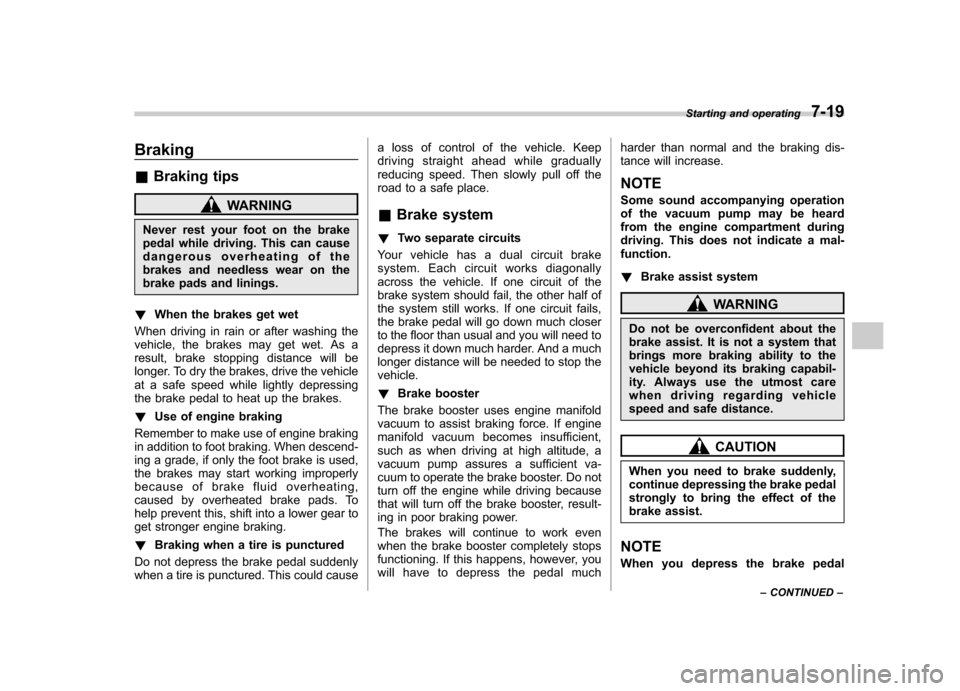
Braking &Braking tips
WARNING
Never rest your foot on the brake
pedal while driving. This can cause
dangerous overheating of the
brakes and needless wear on the
brake pads and linings.
! When the brakes get wet
When driving in rain or after washing the
vehicle, the brakes may get wet. As a
result, brake stopping distance will be
longer. To dry the brakes, drive the vehicle
at a safe speed while lightly depressing
the brake pedal to heat up the brakes. ! Use of engine braking
Remember to make use of engine braking
in addition to foot braking. When descend-
ing a grade, if only the foot brake is used,
the brakes may start working improperly
because of brake fluid overheating,
caused by overheated brake pads. To
help prevent this, shift into a lower gear to
get stronger engine braking. ! Braking when a tire is punctured
Do not depress the brake pedal suddenly
when a tire is punctured. This could cause a loss of control of the vehicle. Keep
driving straight ahead while gradually
reducing speed. Then slowly pull off the
road to a safe place.
& Brake system
! Two separate circuits
Your vehicle has a dual circuit brake
system. Each circuit works diagonally
across the vehicle. If one circuit of the
brake system should fail, the other half of
the system still works. If one circuit fails,
the brake pedal will go down much closer
to the floor than usual and you will need to
depress it down much harder. And a much
longer distance will be needed to stop thevehicle. ! Brake booster
The brake booster uses engine manifold
vacuum to assist braking force. If engine
manifold vacuum becomes insufficient,
such as when driving at high altitude, a
vacuum pump assures a sufficient va-
cuum to operate the brake booster. Do not
turn off the engine while driving because
that will turn off the brake booster, result-
ing in poor braking power.
The brakes will continue to work even
when the brake booster completely stops
functioning. If this happens, however, you
will have to depress the pedal much harder than normal and the braking dis-
tance will increase. NOTE
Some sound accompanying operation
of the vacuum pump may be heard
from the engine compartment during
driving. This does not indicate a mal-function. !
Brake assist system
WARNING
Do not be overconfident about the
brake assist. It is not a system that
brings more braking ability to the
vehicle beyond its braking capabil-
ity. Always use the utmost care
when driving regarding vehicle
speed and safe distance.
CAUTION
When you need to brake suddenly,
continue depressing the brake pedal
strongly to bring the effect of the
brake assist.
NOTE
When you depress the brake pedal Starting and operating
7-19
– CONTINUED –
Page 304 of 420

.Check that the vehicle and trailer are
connected properly. Confirm that
–the trailer tongue is connected
properly to the hitch ball. – the trailer lights connector is con-
nected properly and trailer ’s brake
lights illuminate when the vehicle ’s
brake pedal is pressed, and that the trailer ’s turn signal lights flash when
the vehicle ’s turn signal lever is oper-
ated. – the safety chains are connected
properly.– all cargo in the trailer is secured
safely in position.– the side mirrors provide a good
rearward field of view without a sig-
nificant blind spot.
. Sufficient time should be taken to learn
the “feel ”of the vehicle/trailer combination
before starting out on a trip. In an area free
of traffic, practice turning, stopping and
backing up. ! Driving with a trailer
. You should allow for considerably more
stopping distance when towing a trailer.
Avoid sudden braking because it may
result in skidding or jackknifing and loss ofcontrol. . Avoid uneven steering, sharp turns and
rapid lane changes. .
Slow down before turning. Make a
longer than normal turning radius because
the trailer wheels will be closer than the
vehicle wheels to the inside of the turn. In
a tight turn, the trailer could hit yourvehicle. . Crosswinds will adversely affect the
handling of your vehicle and trailer, caus-
ing sway. Crosswinds can be due to
weather conditions or the passing of large
trucks or buses. If swaying occurs, firmly
grip the steering wheel and slow down
immediately but gradually. . When passing other vehicles, consid-
erable distance is required because of the
added weight and length caused by
attaching the trailer to your vehicle.
1) Left turn
2) Right turn .
Backing up with a trailer is difficult and
takes practice. When backing up with a
trailer, never accelerate or steer rapidly.
When turning back, grip the bottom of the
steering wheel with one hand and turn it to
the left for a left turn, and turn it to the right
for a right turn. . If the ABS warning light illuminates
while the vehicle is in motion, stop towing
the trailer and have repairs performed
immediately by the nearest SUBARU
dealer. ! Driving on grades
. Before going down a steep hill, slow
down and shift into lower gear (if neces-
sary, use 1st gear) in order to utilize the
engine braking effect and prevent over-
heating of your vehicle ’s brakes. Do not
make sudden downshifts. . When driving uphill in hot weather, the
air conditioner may turn off automatically
to protect the engine from overheating. . When driving uphill in hot weather, pay
attention to the water temperature gauge
pointer and AT OIL TEMP warning light
because the engine and transmission are
relatively prone to overheating under
these conditions. If the water temperature
gauge pointer approaches the OVER-
HEAT zone or the AT OIL TEMP warning
light illuminates, immediately turn off the Driving tips
8-27
– CONTINUED –
Page 305 of 420
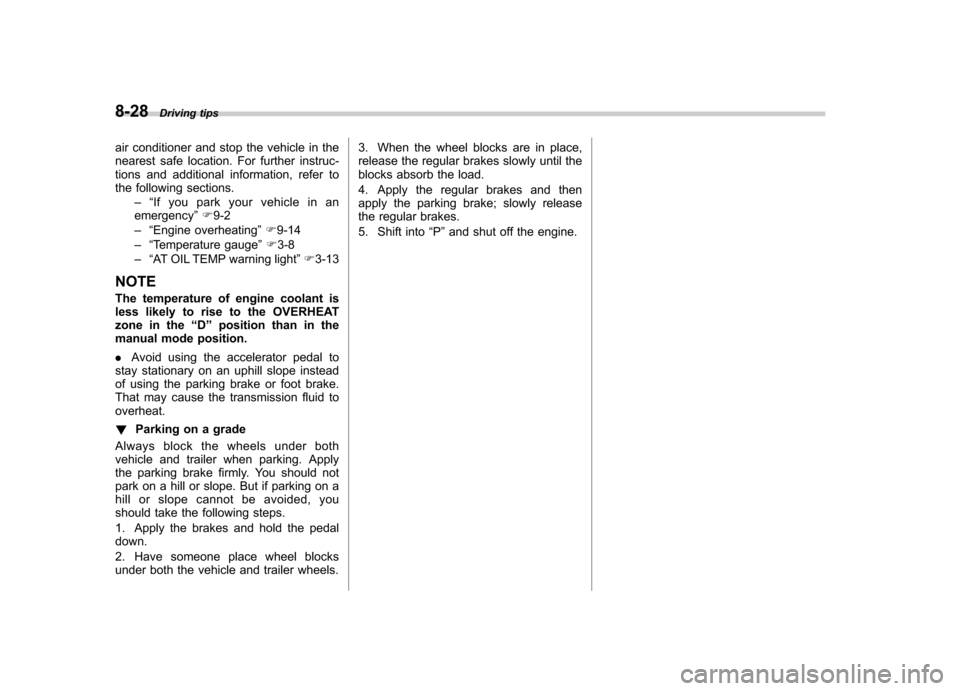
8-28Driving tips
air conditioner and stop the vehicle in the
nearest safe location. For further instruc-
tions and additional information, refer to
the following sections. –“If you park your vehicle in an
emergency ”F 9-2
–“ Engine overheating ”F 9-14
–“ Temperature gauge ”F 3-8
–“ AT OIL TEMP warning light ”F 3-13
NOTE
The temperature of engine coolant is
less likely to rise to the OVERHEAT
zone in the “D ” position than in the
manual mode position. . Avoid using the accelerator pedal to
stay stationary on an uphill slope instead
of using the parking brake or foot brake.
That may cause the transmission fluid tooverheat. ! Parking on a grade
Always block the wheels under both
vehicle and trailer when parking. Apply
the parking brake firmly. You should not
park on a hill or slope. But if parking on a
hill or slope cannot be avoided, you
should take the following steps.
1. Apply the brakes and hold the pedal down.
2. Have someone place wheel blocks
under both the vehicle and trailer wheels. 3. When the wheel blocks are in place,
release the regular brakes slowly until the
blocks absorb the load.
4. Apply the regular brakes and then
apply the parking brake; slowly release
the regular brakes.
5. Shift into
“P ”and shut off the engine.
Page 306 of 420
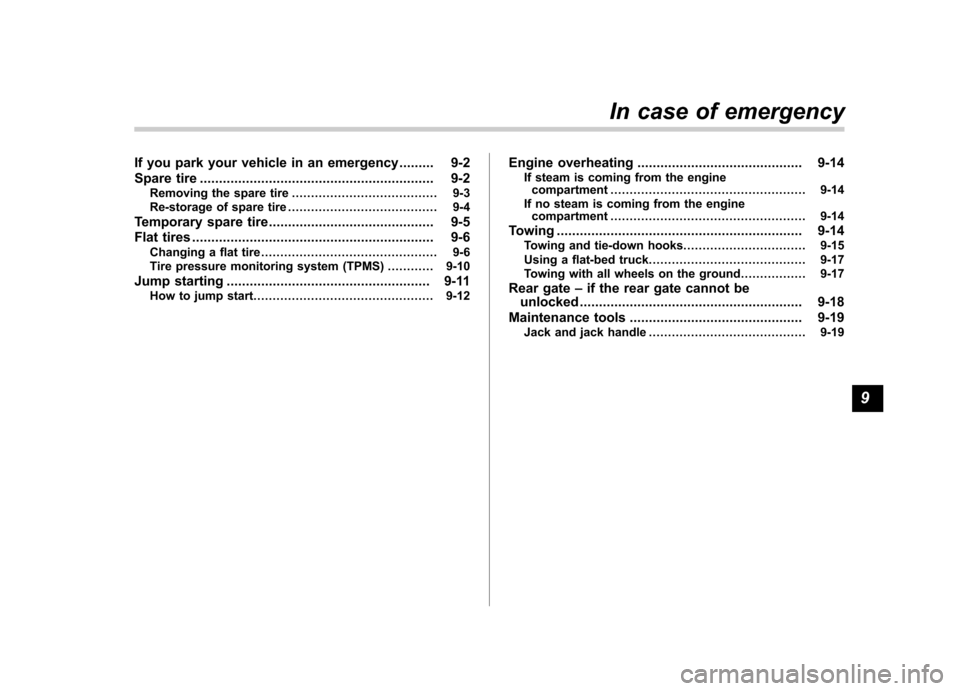
If you park your vehicle in an emergency......... 9-2
Spare tire ............................................................. 9-2
Removing the spare tire ...................................... 9-3
Re-storage of spare tire ....................................... 9-4
Temporary spare tire ........................................... 9-5
Flat tires ............................................................... 9-6
Changing a flat tire .............................................. 9-6
Tire pressure monitoring system (TPMS) . ........... 9-10
Jump starting ..................................................... 9-11
How to jump start ............................................... 9-12 Engine overheating
........................................... 9-14
If steam is coming from the engine compartment ................................................... 9-14
If no steam is coming from the engine compartment ................................................... 9-14
Towing ................................................................ 9-14
Towing and tie-down hooks. ............................... 9-15
Using a flat-bed truck. ........................................ 9-17
Towing with all wheels on the ground ................. 9-17
Rear gate –if the rear gate cannot be
unlocked .......................................................... 9-18
Maintenance tools ............................................. 9-19
Jack and jack handle ......................................... 9-19
In case of emergency
9
Page 319 of 420
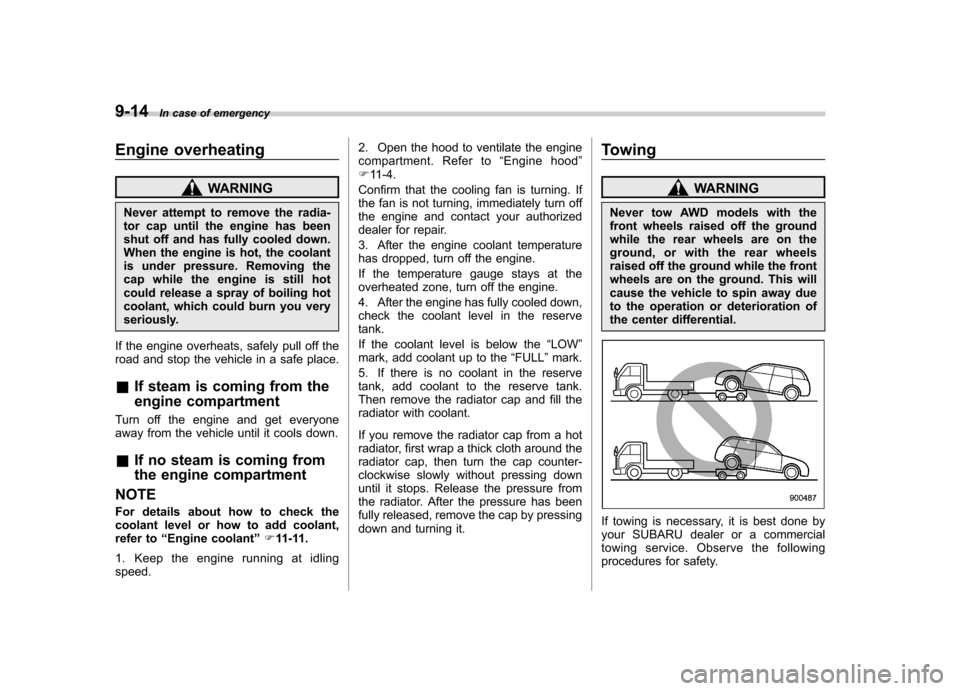
9-14In case of emergency
Engine overheating
WARNING
Never attempt to remove the radia-
tor cap until the engine has been
shut off and has fully cooled down.
When the engine is hot, the coolant
is under pressure. Removing the
cap while the engine is still hot
could release a spray of boiling hot
coolant, which could burn you very
seriously.
If the engine overheats, safely pull off the
road and stop the vehicle in a safe place. & If steam is coming from the
engine compartment
Turn off the engine and get everyone
away from the vehicle until it cools down. & If no steam is coming from
the engine compartment
NOTE
For details about how to check the
coolant level or how to add coolant,
refer to “Engine coolant ”F 11-11.
1. Keep the engine running at idlingspeed. 2. Open the hood to ventilate the engine
compartment. Refer to
“Engine hood ”
F 11-4.
Confirm that the cooling fan is turning. If
the fan is not turning, immediately turn off
the engine and contact your authorized
dealer for repair.
3. After the engine coolant temperature
has dropped, turn off the engine.
If the temperature gauge stays at the
overheated zone, turn off the engine.
4. After the engine has fully cooled down,
check the coolant level in the reservetank.
If the coolant level is below the “LOW ”
mark, add coolant up to the “FULL ”mark.
5. If there is no coolant in the reserve
tank, add coolant to the reserve tank.
Then remove the radiator cap and fill the
radiator with coolant.
If you remove the radiator cap from a hot
radiator, first wrap a thick cloth around the
radiator cap, then turn the cap counter-
clockwise slowly without pressing down
until it stops. Release the pressure from
the radiator. After the pressure has been
fully released, remove the cap by pressing
down and turning it. TowingWARNING
Never tow AWD models with the
front wheels raised off the ground
while the rear wheels are on the
ground, or with the rear wheels
raised off the ground while the front
wheels are on the ground. This will
cause the vehicle to spin away due
to the operation or deterioration of
the center differential.
If towing is necessary, it is best done by
your SUBARU dealer or a commercial
towing service. Observe the following
procedures for safety.
Page 411 of 420
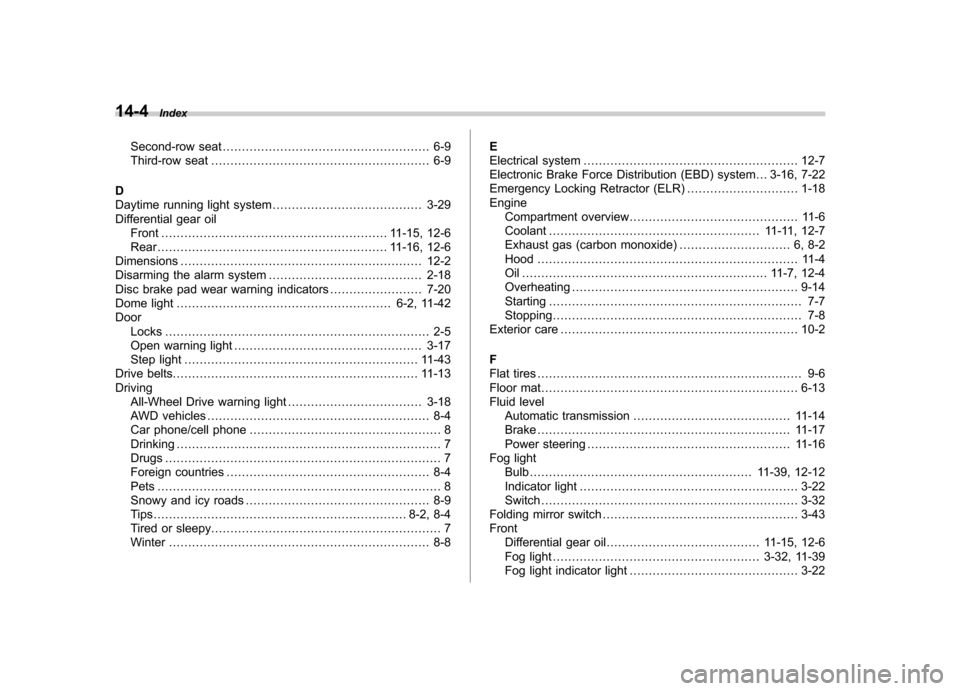
14-4Index
Second-row seat ...................................................... 6-9
Third-row seat ......................................................... 6-9
D
Daytime running light system ....................................... 3-29
Differential gear oil Front ........................................................... 11-15, 12-6
Rear ............................................................ 11-16, 12-6
Dimensions ............................................................... 12-2
Disarming the alarm system ........................................ 2-18
Disc brake pad wear warning indicators ........................ 7-20
Dome light ........................................................ 6-2, 11-42
Door Locks ..................................................................... 2-5
Open warning light ................................................. 3-17
Step light ............................................................. 11-43
Drive belts. ............................................................... 11-13
Driving All-Wheel Drive warning light ................................... 3-18
AWD vehicles .......................................................... 8-4
Car phone/cell phone .................................................. 8
Drinking ..................................................................... 7
Drugs ........................................................................ 7
Foreign countries ..................................................... 8-4
Pets .......................................................................... 8
Snowy and icy roads ................................................ 8-9
Tips.................................................................. 8-2, 8-4
Tired or sleepy. ........................................................... 7
Winter .................................................................... 8-8 E
Electrical system
........................................................ 12-7
Electronic Brake Force Distribution (EBD) system... 3-16, 7-22
Emergency Locking Retractor (ELR) ............................. 1-18
Engine Compartment overview ............................................ 11-6
Coolant ....................................................... 11-11, 12-7
Exhaust gas (carbon monoxide) ............................. 6, 8-2
Hood .................................................................... 11-4
Oil ................................................................ 11-7, 12-4 Overheating ........................................................... 9-14
Starting .................................................................. 7-7
Stopping ................................................................. 7-8
Exterior care .............................................................. 10-2
F
Flat tires ..................................................................... 9-6
Floor mat ................................................................... 6-13
Fluid level Automatic transmission ......................................... 11-14
Brake .................................................................. 11-17
Power steering ..................................................... 11-16
Fog light Bulb .......................................................... 11-39, 12-12
Indicator light ......................................................... 3-22
Switch ................................................................... 3-32
Folding mirror switch ................................................... 3-43
Front
Differential gear oil ........................................ 11-15, 12-6
Fog light ...................................................... 3-32, 11-39
Fog light indicator light ............................................ 3-22
Page 414 of 420

Mirrors...................................................................... 3-38
Moonroof .................................................................. 2-25
Multi function display .................................................. 3-24
N
New vehicle break-in driving .......................................... 8-2
O Odometer .................................................................... 3-6
Oil filter ..................................................................... 11-8
Oil level Engine .................................................................. 11-7
Front differential gear ............................................ 11-15
Rear differential gear ............................................. 11-16
Oil pressure warning light ............................................ 3-13
On-road and off-road driving ...................................... 9, 8-6
Outside Mirror defogger ...................................................... 3-43
Mirrors .................................................................. 3-42
Temperature indicator ............................................. 3-23
Overhead console ........................................................ 6-8
Overheating engine .................................................... 9-14
PParking Brake ................................................................... 7-28
Brake stroke ......................................................... 11-20
Light .................................................................... 11-38
Light switch ........................................................... 3-32
Tips...................................................................... 7-29
Periodic inspections ..................................................... 8-4 Petrol fuel
................................................................... 7-2
Power Door locking switch .................................................. 2-7
Outlets .................................................................. 6-10
Outside mirrors ...................................................... 3-42
Seat ....................................................................... 1-3
Steering ................................................................ 7-18
Steering fluid ................................................ 11-16, 12-7
Windows ............................................................... 2-21
Precautions against vehicle modification ................ 1-28, 1-72
Preparing to drive ........................................................ 7-7
Printed antenna ........................................................... 5-2
RRear Air conditioner ......................................................... 4-9
Combination lights ................................................ 11-39
Differential gear oil ........................................ 11-16, 12-6
Gate ............................................................. 2-24, 9-18
Gate light ...................................................... 6-3, 11-41
Turn signal light .................................................... 11-39
Rear differential Oil temperature warning light ................................... 3-13
Rear Seat Entertainment ............................................. 5-29
Rear view camera ...................................................... 6-21
Rear window Defogger button ..................................................... 3-37
Wiper and washer switch ......................................... 3-35
Wiper blades ........................................................ 11-31
Recommended
Automatic transmission fluid ..................................... 12-7Index
14-7